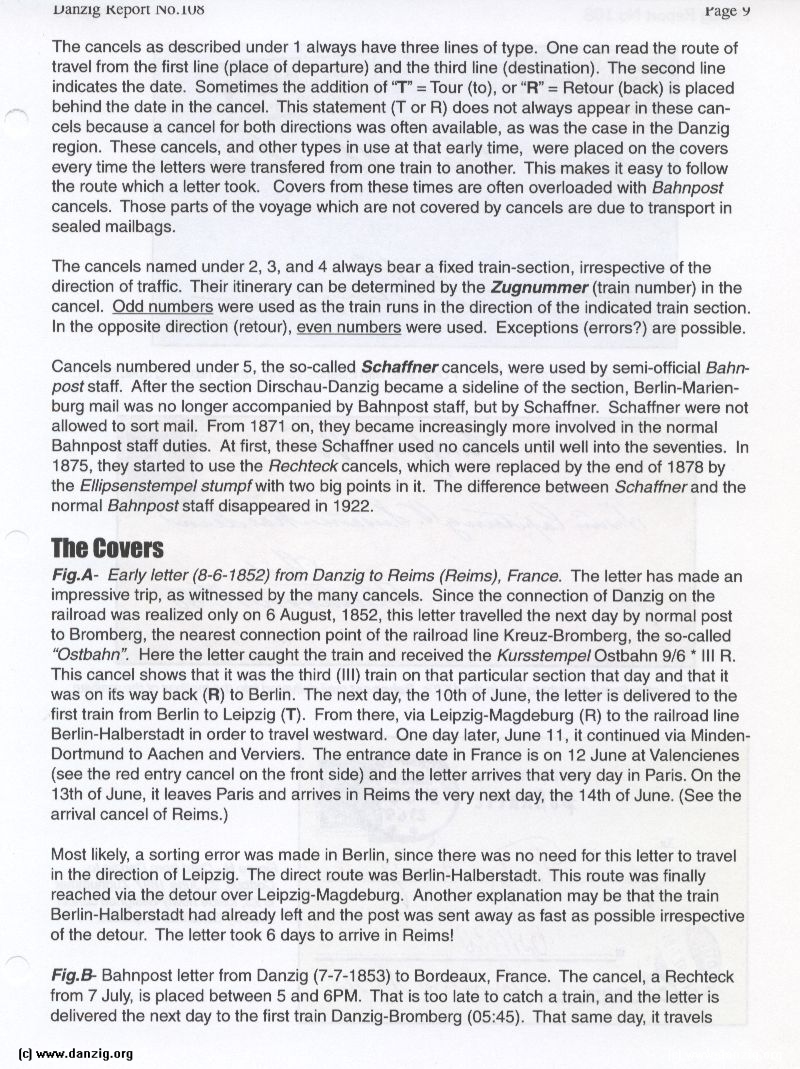
The cancels as described under 1 always have three lines of type. One can read the route of travel from the first line (place of departure) and the third line (destination). The second line indicates the date. Sometimes the addition of ‘T = Tour (to), or “R = Retour (back) is placed behind the date in the cancel. This statement (T or R) does not always appear in these canc els because a cancel for both directions was often available, as was the case in the Danzig region. These cancels, and other types in use at that early time, were placed on the covers every time the letters were transfered from one train to another. This makes it easy to follow the route which a letter took. Covers from these times are often overloaded with Bahnpost cancels. Those parts of the voyage which are not covered by cancels are due to transport in sealed mailbags.
The cancels named under 2, 3, and 4 always bear a fixed train-section, irrespective of the direction of traffic. Their itinerary can be determined by the Zugnummer (train number) in the cancel. Odd numbers were used as the train runs in the direction of the indicated train section. In the opposite direction (retour), veriiwrnbers were used. Exceptions (errors?) are possible.
Cancels numbered under 5, the so-called Schaffner cancels, were used by semi-official Bahnp ost staff. After the section Dirschau-Danzig became a sideline of the section, Berlin-Marienb urg mail was no longer accompanied by Bahn post staff, but by Schaffner. Schaffner were not allowed to sort mail. From 1871 on, they became increasingly more involved in the normal Bahnpost staff duties. At first, these Schatfner used no cancels until well into the seventies. In 1875, they started to use the Rechteck cancels, which were replaced by the end of 1878 by the Ellipsenstempel stumpf with two big points in it. The difference between Schatfner and the normal Bahn post staff disappeared in 1922.
The Covers
Fig.A- Early letter (8-6-1852) from Danzig to Reims (Reims), France. The letter has made an impressive trip, as witnessed by the many cancels. Since the connection of Danzig on the railroad was realized only on 6 August, 1852, this letter travelled the next day by normal post to Bromberg, the nearest connection point of the railroad line Kreuz-Bromberg, the so-called Vstbahn”. Here the letter caught the train and received the Kursstempel Ostbahn 9/6 * Ill R. This cancel shows that it was the third (Ill) train on that particular section that day and that it was on its way back (R) to Berlin. The next day, the 10th of June, the letter is delivered to the first train from Berlin to Leipzig (T). From there, via Leipzig-Magdeburg (R) to the railroad line Berlin-Halberstadt in order to travel westward. One day later, June 11, it continued via MindenD ortmund to Aacheri and Verviers. The entrance date ii France is on 12 June at Valencienes (see the red entry cancel on the front side) and the letter arrives that very day in Paris. On the 13th of June, it leaves Paris and arrives in Reims the very next day, the 14th of June. (See the arrival cancel of Reims.)
Most likely, a sorting error was made in Berlin, since there was no need for this letter to travel in the direction of Leipzig. The direct route was Berlin-Halberstadt. This route was finally reached via the detour over Leipzig-Magdeburg. Another explanation may be that the train Berlin-Halberstadt had already left and the post was sent away as fast as possible irrespective of the detour. The letter took 6 days to arrive in Reims!
Fig.B- Bahnpost letter from Danzig (7-7-1853) to Bordeaux, France. The cancel, a Rechteck from 7 July. is placed between 5 and 6PM. That is too late to catch a train, and the letter is delivered the next day to the first train Danzig-Bromberg (05:45). That same day, it travels
Danzig Report Vol. 1 - Nr. 108 - July - August - September - 2000, Page 9.
Hits: 1875
Added: 28/07/2015
Copyright: 2024 Danzig.org

